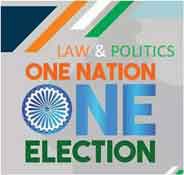Understanding The Basic Philosophy Of The Indian Constitution
Constitution is the supreme law of the land in a country. It is a rule book
of a country which governs the governance of the country. The entire structure
of the government is based on the terms of the constitution. It is an integral
element of a democracy. At present, majority of the countries are having a
constitution. India has the largest constitution in the world and due to this
very fact, it is known as the largest democracy in the world.
Every constitution is driven by some basic philosophy which is the basic ideas and values keeping which in mind the constitutional makers draft the constitution. All the provisions of the constitution reflect this basic philosophy. Like so, Indian constitution also has a core which is embedded deep in each and every article of it.
Like every book, constitution has a preface in the form of a preamble. It is a micro form of the constitution containing what a constitution seeks to establish. It provides us a key to the minds of the constitution makers. Thus, it contains the basic spirit and soul of the constitution.
The preamble of Indian constitution is patterned after the preamble of the US constitution. It provides two major things; first, the nature of state and second, the ideas and objectives which are to be achieved by the Indian society. The terms 'Sovereign, Socialist, Secular, Democratic, Republic' indicate the nature of the Indian state that the constitution seeks to be establish.
On the other hands, the terms 'JUSTICE, LIBERTY, EQUALITY, FRATERNITY' reflect the ideas, values and objectives that the constitution seeks to achieve. It mirrors the basic core of the constitution and that is why, it is referred to as a guide by the judiciary while interpreting the provisions of the constitution. In fact, it has become a convention to consider the preamble and interpret the terms of the constitution in light of the preamble. Thus, it can be glorified as a helping hand to the constitution.
While discussing the basic philosophy of the constitution, the basic structure doctrine cannot be ignored which was gifted by the Supreme Court of India in the case of Kesavananda Bharti V. Union Of India, 1973. It was held in this case that it is not only the letters but spirit of the constitution has also to be respected and preserved.
It is very much true that every constitution can thrive only when its basic spirit is kept. The above-mentioned case is a remarkable case in the list of landmark cases of Supreme Court of India. This case dealt with the question whether parliament can amend anything including fundamental rights in the constitution by using the amending powers given under Article 368 of the constitution.
It was not for the first time that this question had come into debate rather it had been flagged immediately after the enactment of the constitution in the Shankari Prasad V. Union Of India (1951) where the constitutional validity of the first amendment act, 1951, which curtailed the right to property, was challenged and the Supreme court ruled that the power to amend the constitution under Article 368 also includes the power to amend the fundamental rights as the word 'law' in Article 13 includes only ordinary laws and not the constitutional amendment acts and are thus not void under Article 13.
In another case Golak Nath V State Of Punjab, the Supreme Court reversed its earlier stand. In this case, the constitutional validity of the seventeenth amendment act, 1964, which inserted certain state acts in the Ninth Schedule, was challenged. The Supreme Court ruled that the fundamental rights are given a 'transcendental and immutable' position and hence, the parliament cannot abridge or take away any of these rights.
A constitutional amendment act is also a law within the meaning of Article 13 and hence, would be void for violating any fundamental rights. The parliament reacted to the Supreme Court`s judgement in the Golak Nath case by enacting the 24th amendment act, 1971. This act amended Articles 13 and 368. It declared that the parliament has the power to abridge or take away any of the fundamental rights under Article 368 and such an act will not be a law under the meaning of Article 13.
Then came the landmark judgement of Kesavananda Bharati Case which overruled the Golak Nath case and laid down the basic structure doctrine and provided that parliament is empowered to amend any part of the constitution but it cannot violate the basic structure of the constitution. This basic judgement to much extent resolved the long-standing conflict between parliament and judiciary.
It satisfied the parliament as it was given an allowance to amend any part of the constitution except the basic structure. The basic structure was not exclusively defined by the Supreme court rather it was left to be evolved with the demanding circumstances. Take for example, the Minerva Mills Case, in which the Supreme Court invalidated the 42nd amendment act,1976, which excluded judicial review and declared it to be the part of the basic structure. This is the perfect example of active role played by the Indian judiciary to safeguard the constitution and its basic spirit.
If any constitution is to mark success, its basic philosophy has to be carried forward and so is the case with the Indian constitution. Both the letter and spirit of the constitution have to preserved to make our democracy successful and to keep the tag of being the largest democracy not just on the basis of the lengthiest constitution but efficient working constitution. The three organs of the government; legislature, executive and judiciary should uphold and preserve the basic philosophy of the constitution from any invasion for the years to come.
References:
Every constitution is driven by some basic philosophy which is the basic ideas and values keeping which in mind the constitutional makers draft the constitution. All the provisions of the constitution reflect this basic philosophy. Like so, Indian constitution also has a core which is embedded deep in each and every article of it.
Like every book, constitution has a preface in the form of a preamble. It is a micro form of the constitution containing what a constitution seeks to establish. It provides us a key to the minds of the constitution makers. Thus, it contains the basic spirit and soul of the constitution.
The preamble of Indian constitution is patterned after the preamble of the US constitution. It provides two major things; first, the nature of state and second, the ideas and objectives which are to be achieved by the Indian society. The terms 'Sovereign, Socialist, Secular, Democratic, Republic' indicate the nature of the Indian state that the constitution seeks to be establish.
On the other hands, the terms 'JUSTICE, LIBERTY, EQUALITY, FRATERNITY' reflect the ideas, values and objectives that the constitution seeks to achieve. It mirrors the basic core of the constitution and that is why, it is referred to as a guide by the judiciary while interpreting the provisions of the constitution. In fact, it has become a convention to consider the preamble and interpret the terms of the constitution in light of the preamble. Thus, it can be glorified as a helping hand to the constitution.
While discussing the basic philosophy of the constitution, the basic structure doctrine cannot be ignored which was gifted by the Supreme Court of India in the case of Kesavananda Bharti V. Union Of India, 1973. It was held in this case that it is not only the letters but spirit of the constitution has also to be respected and preserved.
It is very much true that every constitution can thrive only when its basic spirit is kept. The above-mentioned case is a remarkable case in the list of landmark cases of Supreme Court of India. This case dealt with the question whether parliament can amend anything including fundamental rights in the constitution by using the amending powers given under Article 368 of the constitution.
It was not for the first time that this question had come into debate rather it had been flagged immediately after the enactment of the constitution in the Shankari Prasad V. Union Of India (1951) where the constitutional validity of the first amendment act, 1951, which curtailed the right to property, was challenged and the Supreme court ruled that the power to amend the constitution under Article 368 also includes the power to amend the fundamental rights as the word 'law' in Article 13 includes only ordinary laws and not the constitutional amendment acts and are thus not void under Article 13.
In another case Golak Nath V State Of Punjab, the Supreme Court reversed its earlier stand. In this case, the constitutional validity of the seventeenth amendment act, 1964, which inserted certain state acts in the Ninth Schedule, was challenged. The Supreme Court ruled that the fundamental rights are given a 'transcendental and immutable' position and hence, the parliament cannot abridge or take away any of these rights.
A constitutional amendment act is also a law within the meaning of Article 13 and hence, would be void for violating any fundamental rights. The parliament reacted to the Supreme Court`s judgement in the Golak Nath case by enacting the 24th amendment act, 1971. This act amended Articles 13 and 368. It declared that the parliament has the power to abridge or take away any of the fundamental rights under Article 368 and such an act will not be a law under the meaning of Article 13.
Then came the landmark judgement of Kesavananda Bharati Case which overruled the Golak Nath case and laid down the basic structure doctrine and provided that parliament is empowered to amend any part of the constitution but it cannot violate the basic structure of the constitution. This basic judgement to much extent resolved the long-standing conflict between parliament and judiciary.
It satisfied the parliament as it was given an allowance to amend any part of the constitution except the basic structure. The basic structure was not exclusively defined by the Supreme court rather it was left to be evolved with the demanding circumstances. Take for example, the Minerva Mills Case, in which the Supreme Court invalidated the 42nd amendment act,1976, which excluded judicial review and declared it to be the part of the basic structure. This is the perfect example of active role played by the Indian judiciary to safeguard the constitution and its basic spirit.
If any constitution is to mark success, its basic philosophy has to be carried forward and so is the case with the Indian constitution. Both the letter and spirit of the constitution have to preserved to make our democracy successful and to keep the tag of being the largest democracy not just on the basis of the lengthiest constitution but efficient working constitution. The three organs of the government; legislature, executive and judiciary should uphold and preserve the basic philosophy of the constitution from any invasion for the years to come.
References:
- Indian Polity book by M. Laxmikant
- The Hindu.com (https://www.thehindu.com/)
- Wikipedia.org (https://www.wikipedia.org/)
- Constitution.org (https://www.constitution.org/)
- India Today.in (https://www.indiatoday.in/)
Law Article in India
Legal Question & Answers
Lawyers in India - Search By City
LawArticles
How To File For Mutual Divorce In Delhi

How To File For Mutual Divorce In Delhi Mutual Consent Divorce is the Simplest Way to Obtain a D...
Increased Age For Girls Marriage

It is hoped that the Prohibition of Child Marriage (Amendment) Bill, 2021, which intends to inc...
Facade of Social Media

One may very easily get absorbed in the lives of others as one scrolls through a Facebook news ...
Section 482 CrPc - Quashing Of FIR: Guid...

The Inherent power under Section 482 in The Code Of Criminal Procedure, 1973 (37th Chapter of t...
The Uniform Civil Code (UCC) in India: A...

The Uniform Civil Code (UCC) is a concept that proposes the unification of personal laws across...
Role Of Artificial Intelligence In Legal...

Artificial intelligence (AI) is revolutionizing various sectors of the economy, and the legal i...








Please Drop Your Comments